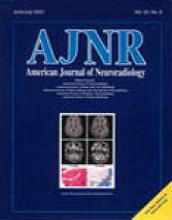Research ArticleBRAIN
Persistence of Gadolinium in CSF: A Diagnostic Pitfall in Patients with End-stage Renal Disease
Ansaar T. Rai and Jeffery P. Hogg
American Journal of Neuroradiology August 2001, 22 (7) 1357-1361;

References
- ↵Staks T, Schuhmann-Giampieri G, Frenzel T, Weinmann HJ, Lange L, Platzek J. Pharmacokinetics, dose proportionality, and tolerability of gadobutrol after single intravenous injection in healthy volunteers. Invest Radiol 1994;29:709-715
- ↵Joffe P, Thomsen HS, Meusel M. Pharmacokinetics of gadodiamide injection in patients with severe renal insufficiency and patients undergoing hemodialysis or continuous ambulatory peritoneal dialysis. Acad Radiol 1998;5:491-502
- ↵Tombach B, Bremer C, Reimer P, Schaefer RM, Ebert W, Geens V, Heindel W. Pharmacokinetics of 1M gadobutrol in patients with chronic renal failure. Invest Radiol 2000;35:35-40
- Schuhmann-Giampieri G, Krestin G. Pharmacokinetics of Gd-DTPA in patients with chronic renal failure. Invest Radiol 1991;26:975-979
- ↵Choyke PL, Girton ME, Vaughan EM, et al. Clearance of gadolinium chelates by hemodialysis: an in vitro study. J Magn Reson Imaging 1995;5:470-472
- ↵Katagiri K, Okada S, Kumazaki T, Tsuboi N. Clearance of gadolinium contrast agent by hemodialysis: in vitro and clinical studies. Nippon Igaku Hoshasen Gakkai Zasshi 1998;58:739-744
- ↵Melhem ER, Jara H, Eustace S. Fluid-attenuated inversion recovery MR imaging: identification of protein concentration thresholds for CSF hyperintensity. AJR Am J Roentgenol 1997;169:859-862
- ↵Eckel TS, Breiter SN, Monsein LH. Subarachnoid contrast enhancement after spinal angiography mimicking diffuse subarachnoid hemorrhage. AJR Am J Roentgenol 1998;170:503-505
- ↵
- ↵Davson H. Dynamic aspects of cerebrospinal fluid. Dev Med Child Neurol (Suppl) 1972;27:1-16
- ↵Carpenter MB. Core Text of Neuroanatomy, (3rd ed). Baltimore: Williams & Wilkins; 1985:1–19
- ↵Bering EA Jr. The cerebrospinal fluid and the extracellular fluid of the brain. Introductory remarks. Fed Proc 1974;33:2061-2066
- Sharp S, Stone J, Beach R. Contrast agent neurotoxicity presenting as subarachnoid hemorrhage. Neurology 1999;52:1503-1505
- ↵
- ↵Stone JA, Sharp S, Castillo M. Subarachnoid contrast enhancement mimicking subarachnoid hemorrhage after coronary angiography. AJR Am J Roentgenol 1999;831–832
- Mamourian AC, Hoopes PJ, Lewis LD. Visualization of intravenously administered contrast material in the CSF on fluid-attenuated inversion-recovery MR images: an in vitro and animal-model investigation. AJNR Am J Neuroradiol 2000;21:105-111
- Mathews VP, Caldemeyer KS, Lowe MJ, Greenspan SL, Weber DM, Ulmer JL. Brain: gadolinium-enhanced fast fluid-attenuated inversion-recovery MR imaging [see comments]. Radiology 1999;211:257-263
- ↵Lev MH, Schaefer PW. Subarachnoid gadolinium enhancement mimicking subarachnoid hemorrhage on FLAIR MR images. Fluid attenuated inversion recovery (letter). AJR Am J Roentgenol 1999;173:1414-1415
In this issue
Advertisement
Persistence of Gadolinium in CSF: A Diagnostic Pitfall in Patients with End-stage Renal Disease
Ansaar T. Rai, Jeffery P. Hogg
American Journal of Neuroradiology Aug 2001, 22 (7) 1357-1361;
Jump to section
Related Articles
- No related articles found.
Cited By...
- Differential diagnosis of hyperintense cerebrospinal fluid on fluid-attenuated inversion recovery images of the brain. Part I: pathological conditions
- Persistence of Gadolinium Contrast Enhancement in CSF: A Possible Harbinger of Gadolinium Neurotoxicity?
- Gadolinium encephalopathy in a patient with renal failure
This article has not yet been cited by articles in journals that are participating in Crossref Cited-by Linking.
More in this TOC Section
Similar Articles
Advertisement






